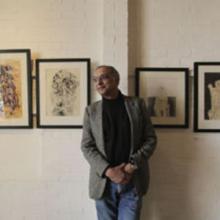A review of Omar Badsha’s ‘Seedtime Retrospective’ at Museum Africa, Johannesburg
Better... read more

The Durban Art Gallery and South African History Online have announced the opening of Under the Umdoni Tree, an exhibition of the work of Omar and Ebrahim Badsha, on the 27th of January 2010.
Including over 70 paintings, drawings, and sculptures executed between the early 1950s and the late 1960s, this timely exhibition explores the rich but little-known history of artists and intellectuals that contributed to the tapestry of life in the Grey Street complex of Durban, one of the best known of Apartheid’s ghettos.
The title of the exhibition pays homage to the Douglas Lane family home in the Durban area of Casbar, where the Badsha family lived from 1917. The tree was planted in the house’s backyard by Omar’s grandmother, and several generations of the Badsha family—including Omar and his father Ebrahim—were born under its shade. A resonant symbol of the struggle to establish roots and community in southern Africa, the uMdoni tree stood watch over a bustling family home which served as a centre of gatherings and discussion about art and politics, and where most of the work in this exhibit was produced. The Badsha family’s connection to Douglas Lane was severed in 1972 when they were forcibly removed under the terms of the Apartheid government’s Group Areas Act.
As the exhibition establishes, Ebrahim Badsha was a member of a little-recognized pioneer generation of black artists in South Africa whose work explored questions of home, modernity, and the challenge of seeing the country in ways that transcended the imposed optic of white domination. Excluded from the commercial galleries and largely overlooked in South African art history, Ebrahim and his peers had a significant influence on the generation of black artists who came to the fore in the 1960s. The pieces in this exhibition were chosen from close to 200 drawings, woodcuts, mono prints that Omar found after his father’s death in 2003. This work had gathered dust for more than 40 years under piles of books, documents, and hundreds of Arabic calligraphy drawings.
Although best known as a social documentary photographer and public historian, Omar Badsha began his career as a visual artist and, in 1965, was one of the first prize recipients in the non-racial Art South Africa Today exhibitions. A member of the post-Sharpeville generation of protest artists (which included his close friend Dumile Feni), Omar played a central role in the debates over the relationship between art and politics that developed in Durban during the mid-1960s and his art work frequently wrestled with the challenges that black artists and intellectuals faced in a period of triumphant Apartheid and intensive repression.
This exhibition is a critical reminder that the rewriting of South African art history and the full recognition of black South Africans’ contributions remains an unfinished task. It is also a timely exhibition in that it is one of the first events that celebrates the work of artists of Indian origin being held in the year when the country is marking the 150th anniversary of the first Indian migrants to the then British Colony of Natal.
The exhibition will be open by Professor Ari Sitas on January 27 and will run until March 21.